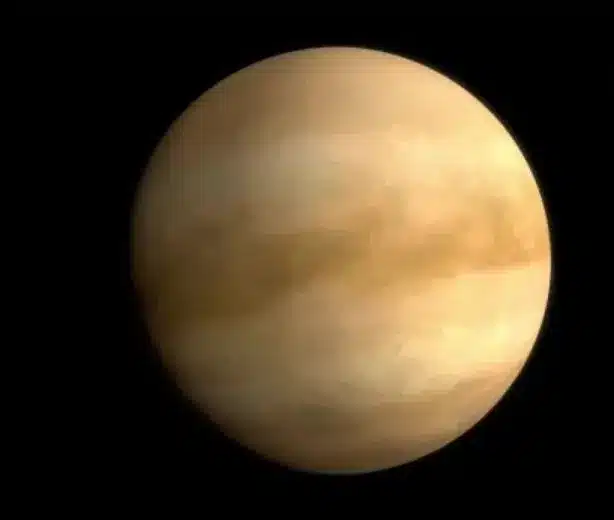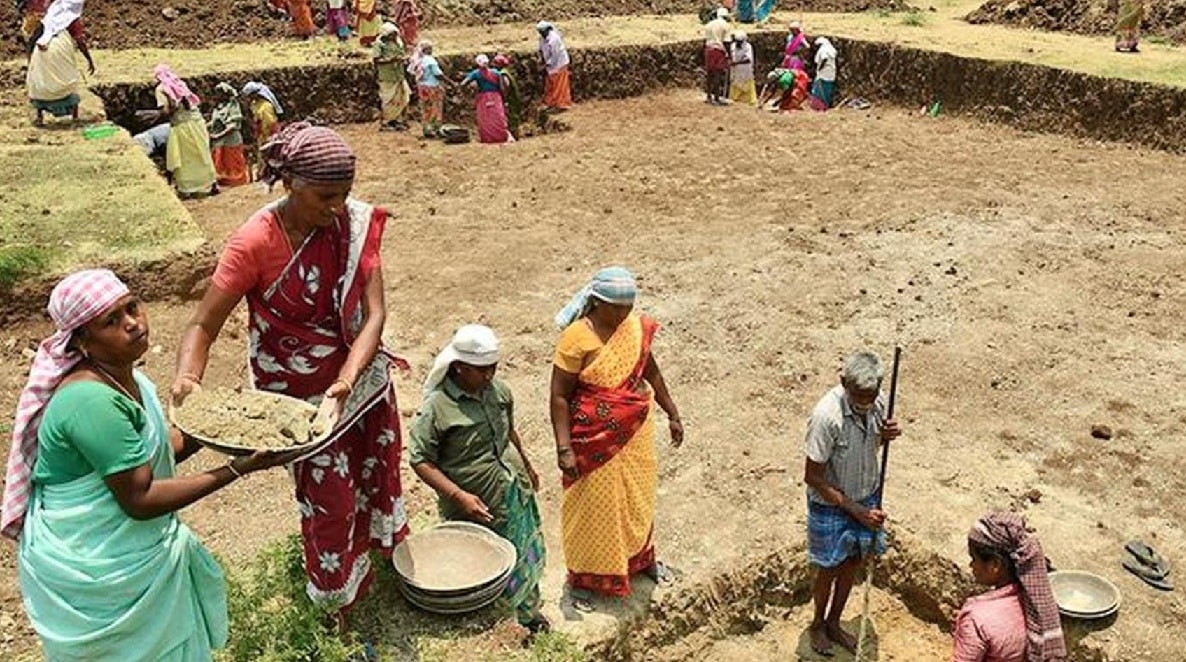What’s in today’s article?
- Why in News?
- What is Venus Orbiter Mission (VOM)?
- Why is India Exploring Venus?
- Venus missions launched by other countries
Why in News?
Recently, the Union Cabinet had approved India’s first mission to Venus, which ISRO plans to launch in March 2028. This will be India’s second interplanetary mission, following the 2013 Mars Orbiter Mission.
The Venus mission aims to study the planet’s surface, sub-surface, atmosphere, and ionosphere from orbit, and will also investigate Venus’s interaction with the Sun. The mission will carry scientific instruments from India and other countries for this exploration.
What is Venus Orbiter Mission (VOM)?
- About
- India’s first planned mission to Venus, “Shukrayaan-1,” will study the planet’s atmosphere, surface, and geological features using advanced scientific instruments.
- The mission will place an orbiter around Venus to gather data on its climate, atmospheric composition, and potential volcanic or seismic activity.
- Instruments like synthetic aperture radar, infrared and ultraviolet cameras, and sensors will examine Venus’s ionosphere and the thick clouds of carbon dioxide and sulfuric acid.
- The mission aims to explore signs of active volcanoes and provide insights into the planet’s unique environment.
- Objectives
- Investigate surface processes and subsurface stratigraphy
- Study the structure, composition, and dynamics of Venus’s atmosphere
- Explore solar wind interactions with the Venusian ionosphere
- Key highlights of the mission
- Timeline
- India’s Venus mission, originally planned for 2023, is now scheduled for launch in March 2028.
- Earth and Venus come closest every 19 months, making this timeline crucial.
- Payloads
- The mission will carry around 100 kg of scientific payloads and follow a similar approach to India’s previous space missions.
- The payloads will conduct experiments to study the flow of interplanetary dust particles, and an experiment to study the high-energy particles entering the Venusian atmosphere leading to its ionisation.
- Another payload will study the composition, structure, variability, and thermal state of Venus’s atmosphere.
- The satellite will gain speed in Earth’s orbit, sling-shot towards Venus, and reach its orbit in about 140 days.
- India’s first attempt at aero-braking
- This mission will also mark India’s first attempt at aero-braking, a technique to slow the spacecraft using atmospheric drag.
- India’s Venus mission will initially place the satellite in a highly elliptical orbit of 500 km x 60,000 km around Venus to save fuel.
- However, this orbit is too high for scientific experiments, so the satellite will be lowered to a more suitable orbit of either 300 x 300 km or 200 x 600 km using aero-braking.
- During this process, the satellite will repeatedly skim the outer layer of Venus’s atmosphere at around 140 km, creating drag to gradually reduce its orbit height.
- This process, which takes about six months, requires precise control—too deep a plunge risks burning up the satellite, while too shallow prolongs orbit adjustment.
- Once the desired orbit is achieved, the satellite will exit Venus’s atmosphere to avoid using excess fuel to maintain its orbit.
- Timeline
Why is India Exploring Venus?
- Unique opportunity to understand Earth’s evolution
- Venus is often called Earth’s twin due to its similar mass, density, and size, making it an important subject for studying Earth’s evolution.
- Scientists believe Venus once had water but is now dry and dusty.
- Clues about climate change, atmospheric dynamics
- The surface temperature of is around 462°C, hotter than Mercury, due to a runaway greenhouse effect.
- Water on Venus likely evaporated, creating more heat and worsening the effect.
- Venus, once believed to have oceans, has now become a sweltering greenhouse world with surface temperatures reaching 470°C.
- By comparing Venus’s climate with Earth’s, scientists hope to uncover clues about climate change, atmospheric dynamics, and planetary evolution.
- Studying Venus can provide insights into Earth’s potential future and the factors that make a planet habitable.
- Technology development capabilities and scientific prowess
- Venus is notoriously difficult to study due to its extreme temperatures and dense atmosphere.
- On Earth, the atmospheric pressure is 1 bar, but on Venus, it’s a staggering 100 bar.
- Its atmosphere is 96.5% carbon dioxide, with sulfuric acid clouds, and it rotates very slowly, with one Venusian day lasting 243 Earth days.
- Its surface temperature is around 462°C, hotter than Mercury.
- No lander has survived the extreme heat for more than a few hours.
- Successful exploration would place India among an elite group of countries with advanced planetary science programs.
Venus missions launched by other countries
- Various missions
- There have been several missions to Venus in the past by the United States, the erstwhile USSR, Japan, and a collaborative mission of the European Space Agency (ESA) with Japan.
- Recently, several space agencies have announced Venus missions:
- NASA’s DaVinci in 2029 and Veritas in 2031
- ESA’s EnVision mission (planned for early 2030s)
- Russia’s Venera-D mission (under development)
- Why the Renewed Race to Venus?
- There is renewed global interest in Venus due to its importance in understanding planetary evolution, climate change, and the potential for life in extreme conditions.
- NASA, the ESA, and Russia have announced Venus missions, especially after the 2020 discovery of phosphine gas, a potential biomarker, in Venus’s atmosphere, sparking speculation about microbial life.
- Venus’s proximity and its value as a comparative study to Earth make it a key target for space exploration.
- Beyond science, the race to Venus fosters international collaboration and highlights space capabilities, with India’s planned mission advancing its global space ambitions alongside the U.S., Russia, and China.
Q.1. What are the objectives of India’s Venus mission in 2028?
India’s Venus mission, Shukrayaan-1, aims to study the planet’s surface, atmosphere, and geological features, including the ionosphere and potential volcanic activity. It will help understand Venus’s climate and its evolution, shedding light on Earth’s possible future.
Q.2. Why is the 2028 Venus mission significant for India?
This mission marks India’s first venture into Venus exploration, positioning ISRO among the elite space agencies studying the planet. It also showcases India’s growing technological capabilities and planetary science expertise on the global stage.
Source: India to launch its first mission to Venus in 2028: Everything you need to know | PIB | India Today | First Post
Last updated on December, 2025
→ Check out the latest UPSC Syllabus 2026 here.
→ Join Vajiram & Ravi’s Interview Guidance Programme for expert help to crack your final UPSC stage.
→ UPSC Mains Result 2025 is now out.
→ UPSC Notification 2026 is scheduled to be released on January 14, 2026.
→ UPSC Calendar 2026 is released on 15th May, 2025.
→ The UPSC Vacancy 2025 were released 1129, out of which 979 were for UPSC CSE and remaining 150 are for UPSC IFoS.
→ UPSC Prelims 2026 will be conducted on 24th May, 2026 & UPSC Mains 2026 will be conducted on 21st August 2026.
→ The UPSC Selection Process is of 3 stages-Prelims, Mains and Interview.
→ UPSC Result 2024 is released with latest UPSC Marksheet 2024. Check Now!
→ UPSC Prelims Result 2025 is out now for the CSE held on 25 May 2025.
→ UPSC Toppers List 2024 is released now. Shakti Dubey is UPSC AIR 1 2024 Topper.
→ UPSC Prelims Question Paper 2025 and Unofficial Prelims Answer Key 2025 are available now.
→ UPSC Mains Question Paper 2025 is out for Essay, GS 1, 2, 3 & GS 4.
→ UPSC Mains Indian Language Question Paper 2025 is now out.
→ UPSC Mains Optional Question Paper 2025 is now out.
→ Also check Best IAS Coaching in Delhi

















